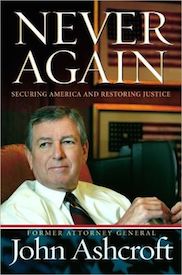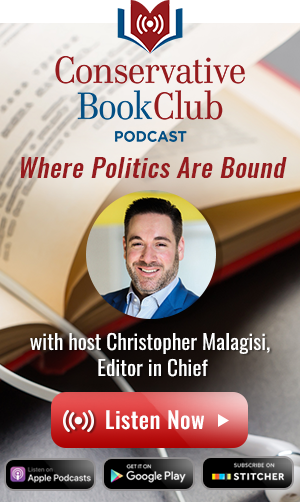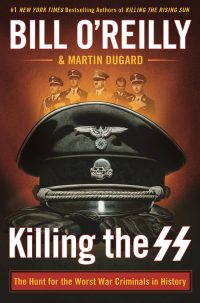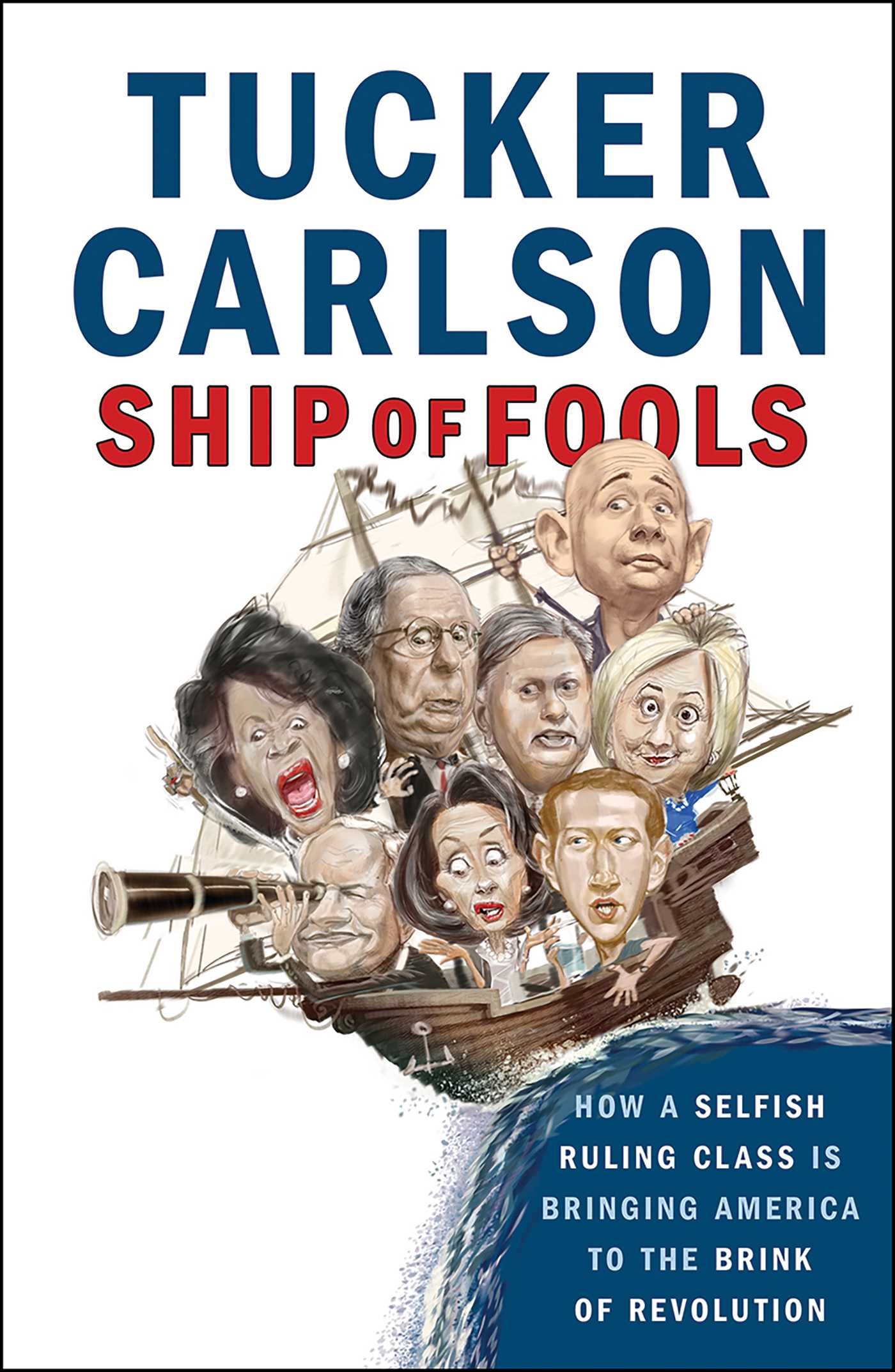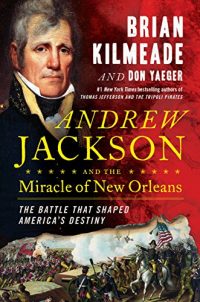Never Again: Securing America and Restoring Justice
One senior administration official described my role in President George W. Bush’s administration as one of ‘spear-catcher.’ Every spear caught is injury avoided; the ones you don’t catch—the ones that catch you—are the ones that really hurt.
This quote from John Ashcroft’s new book, Never Again, conveys much about the task of serving as Attorney General during a period (2001 to 2005) marked by the largest and most devastating terrorist attacks in American history. The metaphor of catching spears is an aptly martial one, for Ashcroft served as a member of a war Cabinet. Early in his tenure, the country was wrenched into a state of war by the attacks of September 11. Haunted, like all Americans, by images of hijacked airplanes and burning buildings, he immediately set about his duty of re-orienting the Justice Department toward the terrorist threat and ensuring that the Department did everything in its power to prevent further attacks. As September 11 made all too clear, the front lines of this war are not only those manned by our soldiers in faraway lands; our enemies have brought the conflict to us, and law enforcement agents and prosecutors confront them on our own soil.
This task, already a Herculean one, was further complicated by the heated criticism of the Bush Administration’s response to September 11. By virtue of his position as the nation’s top law enforcement officer, charged by the President himself with preventing further terrorist attacks, Ashcroft became the face that Americans associated with many of the Administration’s most high-profile and controversial methods for grappling with the terrorist threat. To be the President’s spear-catcher, Ashcroft needed—and had in full measure—a steady willingness to weather the heavy blows of those who disagreed with him.
Those of us who served with him in the Justice Department during this time saw him face this situation with remarkable calm and resolve, borne of the conviction that he and the Administration were fulfilling their obligation to do everything within their lawful authority to protect the American people from further attacks. In the best tradition of leaders in times of crisis, once he determined what he believed was the right thing to do, he went forward without flinching from the political or personal harm he might suffer as a result. Hence, as he says, he “may have been the most controversial attorney general in modern American history. . . . People love me or hate me. Few are indifferent.”
Readers of Ashcroft’s book will detect neither hand- wringing over the size of his “hate” camp nor fire-breathing rhetoric intended to galvanize those in his “love” camp. Rather, they will find a straightforward, clear-eyed account of the staggering challenges that confronted the nation during Ashcroft’s service as Attorney General and his efforts to confront those challenges and prevent further loss of American life. While his role was an intensely public one, Ashcroft’s book provides revealing background details that bring to light his character and the deliberations and decisions made in the wake of the September 11 attacks. Ashcroft’s writing often humanizes him—for example, in the weeks after September 11, he exhibits the all-too-human reactions of anger, frustration and fatigue—and tempers his public caricatures with a welcome measure of truth and sanity. Even those who have thrown spears of their own may find admiration for his dedication to public service, great determination and clarity of purpose.
Never Again begins at a point in Ashcroft’s career that has since been eclipsed by his record as Attorney General: his unsuccessful effort in 2000 to win re-election to the U.S. Senate from Missouri. Before he was elected to the Senate, Ashcroft served for two years as Missouri’s state auditor, two years as state assistant attorney general, two terms as state attorney general and two more terms as the governor of Missouri—a twenty-year record in state government that showcases his deep commitment to public service. With immense dignity, he declined to contest defeat at the hands of former Missouri Governor Mel Carnahan—who had perished in a plane crash two weeks earlier: “There were already loud, contentious voices shouting and arguing with one another over the Bush-Gore results. We didn’t need any more divisiveness.”
The book’s title is adapted from the instructions Ashcroft received from President Bush on the morning of September 12: “Don’t ever let this happen again.” Ashcroft adopted the words “Never again” as a personal motto for the remainder of his time as Attorney General. Never again, he resolved, would Americans suffer as they had on September 11.
Like Ashcroft, many Americans remember vivid and personal details of the September 11 attacks: where they were when they heard the news; when they first viewed the horrifying images that became seared into the nation’s collective consciousness; whom they telephoned immediately after learning of the tragedy. Ashcroft’s own memories are as vivid and pungent as anyone’s. He can “still see the doomed leaping from the World Trade Center, and smell the stench of the rubble.” His powerful recollections of that day bring back one particularly terrifying aspect of the attacks:
We did not know whether more attacks were imminent. Four aircraft had crashed—two in New York, one in Washington and one in Pennsylvania—but still others were sending out distress signals. These airplanes’ pilots responded that the mayday signals were unintentional, but how were we to know whether or not a terrorist was holding a knife or a gun to the captain’s throat as we answered a mayday call? . . . How many other planes were still out there with madmen at or near the controls?
Ashcroft surveyed the carnage, stricken not only as a citizen, but also as an Attorney General responsible for his fellow citizens’ safety.
The most striking aspect of Ashcroft’s recollections of September 11, however, is his account of the intense and exhausting weeks to follow. Ashcroft’s descriptions of the Government’s response to the attacks convey the great extent to which he assumed personal responsibility for the prevention of further terrorist attacks on American soil. He admits that many considered his mission an impossible one. Indeed, a common saying in the Ashcroft Justice Department captured the difficulty of the nation’s struggle against terrorism: “The terrorists can succeed if they hit just a single, but we have to hit a home run every day.” And while the stakes in the struggle against terrorism could not be higher, the hunt for terrorists is, as Ashcroft writes, a “game of inches”—a painstaking and difficult slog that must continue because “every incremental step matters” and “each tiny bit of information can make a difference.”
Lawyers and agents in the Department often saw that Ashcroft’s commitment to the American people’s interests included a deep and abiding respect for the Constitution. This respect must have made it difficult indeed for him to bear accusations that he was riding roughshod over Americans’ civil liberties. Before September 11, he demonstrated his commitment to constitutional principles in the execution of Oklahoma City bomber Timothy McVeigh. When the FBI revealed that more than three thousand pages of documents had not been handed over to McVeigh’s defense team, Ashcroft delayed the convicted killer’s execution and ordered a methodical sweep of all FBI offices worldwide for any other relevant documents. As painful and embarrassing as the matter was, Ashcroft insisted that “[i]t is not enough that we have a guilty defendant. We must have an innocent system as well.” Ashcroft’s commitment to the integrity of our constitutional system was never far from the surface, even during the state of extreme pressure and exhaustion that characterized the weeks after September 11. Days after the September 11 attacks, even in the midst of intense discussions of the best way to pursue and apprehend terrorist suspects, he exhorted his team to “think outside the box, not outside the Constitution.” Echoed long after Ashcroft issued it, this recurring refrain served as a valuable guidepost for the Department’s efforts.
Ashcroft would need such intense focus on his goal of “never again” in order to engineer the necessary and fundamental changes in the Justice Department’s mission and mindset. The magnitude of change required was daunting. The Department had to fundamentally restructure its counterterrorism operations by building a whole new infrastructure, designed to track and hunt terrorists, arm agents and officers with appropriate technological and legal tools, and instill an unfamiliar culture of prevention.
Making these crucial changes required everyone in the Department to understand that their top priority was now the prevention of terrorist attacks. For decades, the FBI and the Department had excelled at determining who had broken the law and prosecuting them for it—after the fact. They now had to move out of their comfort zone. The President’s charge to Ashcroft forced them to focus on prevention. Pursuing and prosecuting terrorists after an attack obviously remained part of the Department’s mission, but it could not be the focus of its efforts. The Department and the Bureau had to become proactive, not reactive. Old models of law enforcement and deterrence would no longer work with adversaries who not only accept but glorify killing themselves in the course of attacking innocent people.
This shift in focus, as simple as it may seem to some readers, represented a significant break with the past. While the protections built into our criminal process guarantee criminal defendants a fair shake, many of these protections are simply inconsistent with a prevention-oriented (as opposed to prosecution-oriented) approach. Ashcroft describes the first meeting of the National Security Council after September 11, at which participants discussed ways to pursue those responsible for the attacks. When the concern was voiced that some of these tactics would impair the Government’s ability to prosecute, the group quickly and unanimously agreed that “[p]revention has to be our top priority.” Ashcroft and FBI Director Robert Mueller underscored the importance of this mission by meeting face-to-face every morning to discuss current terrorist threats. If anyone within the Department or the Bureau had any doubts as to the emphasis placed on the mission of terrorism prevention, these doubts were quickly dispelled by the fact that the Attorney General and the Director of the FBI deemed it necessary to discuss this one topic, face to face, day in and day out.
An important part of the Department’s commitment to prevention was its “spit on the sidewalk” policy. Bobby Kennedy’s Justice Department had used a similar approach to crack down on organized crime: If a terrorism suspect ran afoul of the law in any way, even by spitting on the sidewalk, the Government would apprehend and charge him. The Department relied heavily on immigration violations—expired visas, for example—in order to detain and/or deport terrorism suspects lawfully. Ashcroft describes this approach as one that bought valuable time to gather more information, connect dots, and disrupt potential terrorist plots, all in a manner consistent with the Constitution.
Another critical change that vastly improved the Department’s ability to thwart terrorist attacks was the elimination of the “wall” between law enforcement and intelligence efforts on international terrorism investigations. Previously, prosecutors and FBI agents conducting criminal terrorism investigations were generally restricted from sharing information with their counterparts in the intelligence community who were keeping terrorists under surveillance. In other words, different parts of the Government’s anti-terrorism network were working independently, rather than sharing and leveraging everything they knew about the terrorist threat. After September 11, the Department’s leadership recognized the grave dangers of this approach and proposed to Congress that the wall be torn down. Congress agreed, allowing all of the nation’s anti-terrorism resources to work hand-in-hand.
In spite of the high stakes involved, and the glaring need for change at the Department, such change did not come easily. Like most large institutions with long and proud histories, the FBI and the Justice Department were slow to embrace change; no matter how urgent the need to turn, large vessels like these organizations require a firm and determined hand at the helm to commit to a new course. Given the radical re-tooling required, the institutional hurdles present and the time pressure involved, Ashcroft’s efforts yielded remarkable results.
The results of all of these efforts after September 11, 2001? During the remainder of Ashcroft’s tenure as Attorney General and the service of his successor in that post, the United States has not suffered another terrorist attack on its soil. To be sure, no one can attribute the length of this respite to any single factor, and Ashcroft makes no attempt to take credit for it. Indeed, he provides a sobering reality check by intoning solemnly that we “will suffer more terrorist attacks during this war with al Qaeda. They are fanatical, relentless, and patient. . . . This network will hit us again when they can.” Nonetheless, Ashcroft’s efforts have surely enabled the nation’s antiterrorism network to gain significant ground in the “game of inches.”
Ashcroft’s memoir accurately conveys to readers the enormous amount of time, energy and resources that the Justice Department devoted to the prevention of further terrorist attacks. What the book does not provide, however—and likely could not provide, given editorial constraints—is a comprehensive depiction of the many other law enforcement priorities that the men and women of the Department continued to tackle after September 11. The Department remains responsible for enforcing the entire gamut of federal criminal law, including corporate fraud, drug trafficking, child exploitation, tax crimes, antitrust violations, intellectual property theft, extraditions and other forms of coordination with foreign law enforcement authorities—the list goes on and on. These efforts had to, and did, continue, and readers would be well served by a fuller portrayal of Ashcroft’s tenure as Attorney General.
Ashcroft has given readers much food for thought. His call for “unyielding mental toughness” in the fight against terrorism, his prescriptions for continued advances in our ability to prevent terrorist attacks, and the descriptions of his own efforts to protect our country make for sobering yet inspiring reading.
Book Review from The Federalist Society, by Christopher Wray and Robert Hur
Tags: John Ashcroft, Never Again: Securing America and Restoring Justice
- The Author
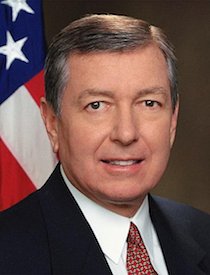
John Ashcroft
John Ashcroft is a businessman, former United States Attorney General, U.S. Senator, and Governor of Missouri. As Attorney General, and […] More about John Ashcroft.




